
About Flag of Afghanistan
The Afghanistan flag is a powerful representation of the nation’s identity and values. It is a visual embodiment of Afghanistan’s rich history, cultural diversity, and aspirations for peace, unity, and progress. The flag, with its distinctive design and colors, holds deep significance for the Afghan people.
History of the Afghanistan Flag
The history of the Afghanistan flag dates back to the early 18th century when the country was under the rule of the Hotaki dynasty. Over the years, the flag has evolved in response to political changes and the aspirations of the Afghan people. It has seen various iterations and modifications, each reflecting the prevailing ideologies and visions of the nation.
| National Symbol(s): | lion |
| National colors: | red, green, black |
| National Anthem: | |
| Name: | “Milli Surood” (National Anthem) |
| Lyrics/Music: | Abdul Bari JAHANI/Babrak WASA |
Facts about the Afghanistan flag |
|---|
| Country | Afghanistan |
|---|---|
| Designed by | NA |
| Adopted | January 4, 2004 |
| Revision | 20 different flags |
| Design and Colors | A vertical tricolor of black, red, and green charged in the center with the national emblem |
| Size Ratio | 2:3 |
Design and Colors
The Afghanistan flag features three vertical stripes of black, red, and green, with the national emblem in the center. The black stripe represents the dark past and the struggles the Afghan people have endured. The red stripe symbolizes the valor, courage, and resilience of the nation. The green stripe represents hope, prosperity, and a bright future for Afghanistan.
Symbolism of the Afghanistan Flag
The Afghanistan flag is rich in symbolism. The national emblem at the center consists of a mosque with a mihrab, a pulpit, and the Shahada, the Islamic creed. It represents the predominant religion of Islam in Afghanistan and highlights the country’s cultural heritage and spiritual values.
Historical Changes
Throughout its history, the Afghanistan flag has undergone several modifications. Notable changes include the removal of the royal crown and changing designs during different political regimes. These changes often reflected shifts in power, ideology, and the social fabric of the nation.
National Holidays and Flag Display
The Afghanistan flag holds a significant place during national holidays and events. It is proudly displayed in public places, government buildings, schools, and homes across the country. Flag-raising ceremonies and parades are conducted to celebrate occasions of national importance and unity.
Respect and Etiquette
The Afghanistan flag commands great respect and should be treated with utmost dignity. It should never touch the ground, be defaced, or used for inappropriate purposes. Displaying the flag correctly and adhering to flag etiquette is a sign of reverence for the nation and its people.
International Recognition
The Afghanistan flag represents the country on the international stage. It is recognized and respected by nations around the world, symbolizing Afghanistan’s sovereignty, identity, and commitment to peace and cooperation.
Controversies and Challenges
Like many national flags, the Afghanistan flag has faced controversies and challenges. It has been a target of desecration and political debates. However, the flag has remained a unifying symbol, reminding the Afghan people of their shared heritage and aspirations.
Flag-related Art and Crafts
The Afghanistan flag has inspired a variety of artistic expressions and crafts. It is often depicted in traditional Afghan art, including calligraphy, embroidery, and paintings. These artistic interpretations celebrate the flag’s symbolism and showcase the creativity and talent of Afghan artisans.
The Afghanistan Flag and Sports
The Afghanistan flag holds a special place in sports events. Athletes proudly carry the flag during international competitions, representing their nation’s strength, determination, and sportsmanship. The flag becomes a source of inspiration and unity for the Afghan athletes and their supporters.
The Flag as a Unifying Symbol
In a nation as diverse as Afghanistan, the flag serves as a unifying symbol. It transcends ethnic, linguistic, and regional differences, fostering a sense of belonging and national pride. The flag reminds the Afghan people of their shared identity and the collective journey towards a better future.
The Afghanistan Flag in Modern Times
In modern times, the Afghanistan flag continues to represent the hopes and dreams of the Afghan people. It stands as a symbol of resilience, progress, and the pursuit of peace. The flag serves as a reminder of Afghanistan’s past struggles and its unwavering determination to build a prosperous and harmonious future. Learn more
FAQs
Q1: What do the colors of the Afghanistan flag represent?
The black stripe represents the past struggles, the red stripe symbolizes valor and courage, and the green stripe represents hope and prosperity.
Q2: How has the Afghanistan flag changed over time?
The Afghanistan flag has undergone modifications throughout history, reflecting political changes and shifting ideologies.
Q3: Is the Afghanistan flag recognized internationally?
Yes, the Afghanistan flag is recognized and respected by nations around the world as the national flag of Afghanistan.
Q4: What is the significance of the national emblem on the Afghanistan flag?
The national emblem on the Afghanistan flag represents the Islamic faith, cultural heritage, and spiritual values of the Afghan people.
Q5: How does the Afghanistan flag serve as a unifying symbol?
The Afghanistan flag transcends ethnic and regional differences, fostering a sense of national pride and belonging among the diverse Afghan population.

